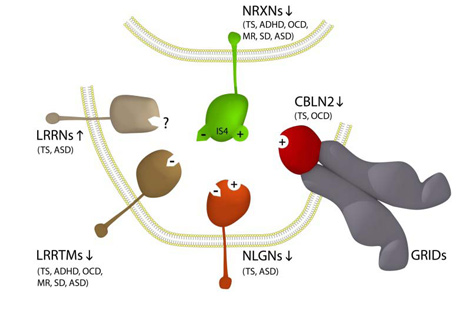Genes in genes help crack genetic code for Tourette syndrome
New evidence elucidates the mystery of the genetic basis of Tourette syndrome (TS) that has puzzled medical researchers for over a century. This remarkable discovery linking genes, brain, mind and behaviour provides unparalleled insight into the biological basis of human behaviour.
The genetic basis of TS was apparent from the time of its original description, albeit the genes involved had eluded scientists for decades.
Leading geneticist, Associate Professor Raymond Clarke, says "it was as if the genes were in hiding – resulting in decades of genetic findings to appear as a disconnected assortment of odds and ends, often in conflict with each other."
Tourette syndrome affects up to 1 percent of school age children and is characterised by a wide range of involuntary movements (motor tics) and sounds or vocalizations (vocal tics). High rates of TS inheritance within families had enticed many researchers to search for a gene of major effect. Many obscure yet informative findings were passed-over in favour of candidate gene studies within preferred neurological pathways.
However, late in 2012 all that changed with the publication of the first pathogenetic model for Tourette syndrome (Translational Psychiatry 2012, Sep 4;2:e158).
The breakthrough came when Associate Professor Clarke, a scientist at the Ingham Institute and University of Western Sydney's School of Medicine, recognised that two genes repeatedly disrupted in TS had other important neurological genes located or nested inside.

Pathogenetic model for Tourette Syndrome
Associate Professor Clarke says that recognising the importance of these nested 'insiders' ultimately led to "cracking the genetic code for Tourette syndrome".
These nested genes provided the first important piece in the larger TS puzzle which has now emerged as arguably the most highly integrated and tightly focussed genetic model for any of the neuropsychiatric disorders.
"If we had linked the TS genes to a common neurological pathway we would have been ecstatic. However, when we realised that all five disrupted TS genes, or their nested insiders, coded for related neuronal cell adhesion molecules we were stunned," says Associate Professor Clarke, from the UWS School of Medicine.
More good news was soon to follow as it was realised that these TS genes encompass the full complement of gene families encoding neurexin trans-synaptic ligands – a key set of proteins that actually compete with each other to form 'neuronal circuitry' within the brain.
"The unbiased and near exclusive focus of the emergent model on competition for neurexin binding reinforces the importance of neurexin connections for our capacity to control behaviour," says Associate Professor Clarke.
Numerous other nested genes, also appear to be implicated in both Tourette's and Autism Spectrum Disorder (ASD) aiding researchers to now stratify behavioural anomalies at the genetic level.
"The really interesting challenge here will be understanding how similar mutations result in varied behavioural phenotypes," says Associate Professor Clarke.
According to co-researcher and clinical expert Professor Valsamma Eapen at the Ingham Institute and University of New South Wales, Australia, this is due to some of these genes converging in their effect on broad domains of brain function through their impact on neurodevelopment and consequent overlap with other neurodevelopmental disorders including Attention Deficit Hyperactivity Disorder (ADHD), Obsessive Compulsive Behaviours (OCB) and ASD.
The challenge is to link these varying clinical phenotypes to specific neurocognitive correlates and with the genetic architecture, says Professor Eapen.
Perhaps the answer also relates to variations in the structural context of the genes impacting dose and timing of effects.
"To think that a gene's proximity to other genes can impact our capacity to control thought, movement and behaviour raises important questions regarding the relationship between genomic structure and behavioural controls within our minds."
8 April 2013
Diagram sourced from Translational Psychiatry 2012, Sep 4;2:e158
Mobile options:

